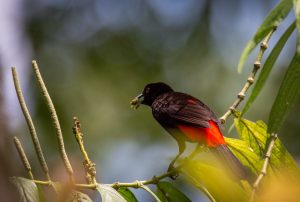Walking a fine line: How chemical diversity in plants facilitates plant-animal interactions
by Virginia Tech
9/9/2020
We aren’t the only beings who enjoy feasting on tasty fruits like apples, berries, peaches, and oranges. Species like bats, monkeys, bears, birds, and even fish consume fruits — and plants count on them to do so.

A male Passerini’s tanager, Ramphocelus passerinii, eats the fruit of Piper sancti-felicis. Photo by Bernadette Wynter Rigley.
Wildlife disperse their seeds by eating the fruit and defecating the seed elsewhere, thus carrying the fruit farther away and spreading the next generation of that plant. But attracting wildlife might also mean attracting harmful organisms, like some species of fungi.
Plants walk a fine line between attraction and repulsion, and to do this, they evolved to become complex chemical factories. Chemical ecologists at the Whitehead Lab at Virginia Tech are working to uncover why plants have such diverse chemicals and to determine the functions of these chemicals in plant-microbe and plant-animal interactions.
“There is still so much we don’t know about the chemical compounds plants use to mediate these complicated interactions. As we continue to lose global biodiversity, we are also losing chemical diversity and the chance for discovery,” said Lauren Maynard, a Ph.D. candidate in the Department of Biological Sciences within the College of Science.
Piper sancti-felicis is a neotropical shrub related to Piper nigrum, which produces black peppercorn. Although P. sancti-felicis isn’t as economically important as its peppery cousin, it fulfills an important ecological role as one of the first plants to colonize a recently disturbed area. It also serves as an important food source for wildlife, especially bats and birds.
At La Selva Biological Station in Costa Rica, Maynard and a team of international ecologists worked to better understand the evolutionary ecology of P. sancti-felicis. Their findings were recently published in Ecology and serve as a step forward in understanding why plants have such great chemical diversity.
Read more here: https://vtnews.vt.edu/articles/2020/08/fralinlifesci-maynard-whitehead-chemical-diversity-plants.html
Read the Ecology paper here: https://esajournals.onlinelibrary.wiley.com/doi/abs/10.1002/ecy.3192